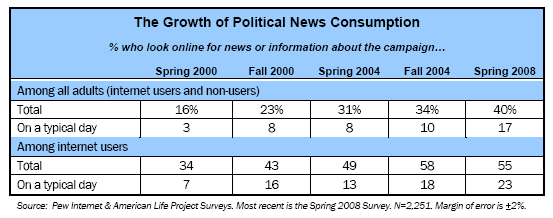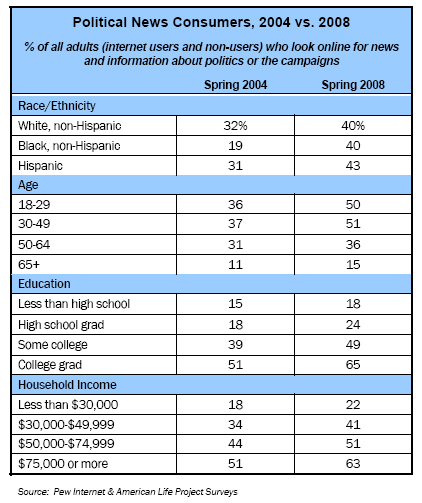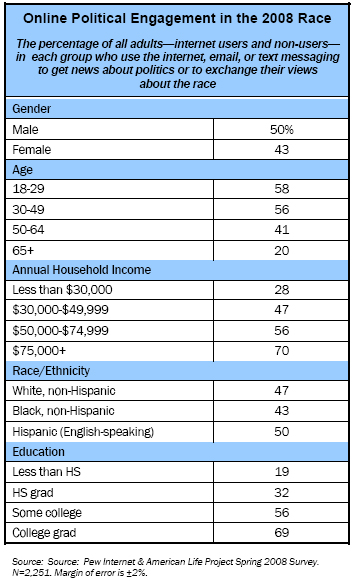Introduction
The 2008 presidential election race has produced its share of internet firsts. Three of the Democratic candidates—John Edwards, Hillary Clinton, and Barack Obama—essentially declared their candidacies online. Obama has broken fundraising records, mostly through online contributions. Citizen questions for key party debates were solicited and delivered via videos posted on YouTube—including one from a snowman. Politics has its own channel on YouTube, and individual candidates also have their own channels. Libertarian Republican Ron Paul established a special presence online that sustained him through the early caucus and primary season.
The presidential candidates are now recruiting supporters through profiles on social networking sites such as Facebook and MySpace, and their supporters themselves are creating candidate communities on those sites. Indeed, Obama has integrated social networking online and offline as a core element of his outreach and mobilization.
In addition, a series of major news stories have been broken or given powerful urgency through online activity, including:
- Obama’s comments at a San Francisco fundraiser, when he said small-town voters have become “bitter” over job losses and that they “cling to guns or religion or antipathy,”” were first recorded as an MP3 and then published by a blogger Mayhill Fowler.8 The event became a central narrative of the campaign heading into the Pennsylvania primary.
- Stories about the sermons by Obama’s preacher Jeremiah Wright were stirring as early as February 2007,9 and then grew to blockbuster proportions when a story and tapes of him saying, “God damn America,” were posted by ABC News on March 13, 2008.10 The story grew in power as Obama reacted to it; the sermons/reactions consumed the blogosphere and were viewed millions of times on YouTube. The ensuing furor led Obama to repudiate Wright and eventually to part ways with his church. As of June 10, Obama’s speech on racial issues in the wake of the controversy, which was posted by several people, had been viewed more than 6.5 million times on YouTube.
- Sermons by preacher John Hagee, a backer of Republican John McCain, came to prominence when liberal blogger Bruce Wilson posted an audio tape of Hagee arguing that Hitler was a “divine agent sent by God to chase Europe’s Jews towards Palestine.”11 That prompted McCain to break with Hagee.
- Clinton was challenged when she claimed that when she was First Lady she came under sniper fire during a trip to Bosnia in 1996, and that turned out not to be the case. The potency of the story grew when CBS tapes of the trip were posted on YouTube.
- The relationship between bloggers and candidates became more noteworthy. Unprecedented numbers of bloggers are being credentialed to cover the party conventions. Edwards first hired bloggers Amanda Marcotte and Melissa McEwan to promote his candidacy, but then let left the race when their previous controversial comments were unearthed and challenged by conservative bloggers.12 McEwan referred to conservative Christians as “Christofascists,” and Marcotte said the Catholic Church’s prohibition on the use of birth control forced women to be “more tithing Catholics.”
Moreover, the punch-counterpunch rhythms of the campaign are now usually played out online in emails and videos rather than in faxed press releases and 30-second ads.
Added up, all this means that the bloggers, the growing activity on social networking sites, and the number of viewers of politically relevant YouTube videos have become a key part of at least some campaign events this election cycle. In addition, the technology-assisted developments are unfolding at the same time that younger, tech-embracing voters are playing a particularly prominent role at the ballot box, especially in the Democratic race. From the very first contests, voters between ages 18 and 30 have voted in greater numbers throughout the nation than in previous races.13 And there is mounting evidence that they are blending their interest in Democratic matters with their enthusiasm for using the internet and cell phones.14 In this season, just the 12th year of presidential politics online, there is no disputing the fact that the internet has moved from the periphery to the center of national politics.
Some 40% of all adults have used the internet to get political news and information about the campaign so far, up from 31% at the same point in the 2004 presidential race.
In a new survey, we find that the dramatic rise of the internet in politics continues and expands. There is a larger population of people going online to get political news and information at this point of the 2008 contest than at any time in the 2004 election. Some 40% of all adults have gone online to get political news and information at this stage of the 2008 race, compared with 31% of adults who got political news and information at a similar point in the 2004 campaign. In keeping with the high level of overall interest about the 2008 campaign, we also find that wired Americans are going online for news about the race with a greater degree of regularity than in the past. Among internet users, 23% went online to look for news about the campaign on a typical day, compared with 13% at the same point in the 2004 race and just 7% in the spring of 2000.

Much of the growth in online news consumption since our spring 2004 survey has occurred among the young, those with college experience, and those who live in higher-income households.
Particularly notable is the rise in online political news consumption by African-Americans, 40% of whom (representing 67% of online African-Americans) now go online for news or information about the campaigns, up from just 19% at the same time period in the 2004 race.
It is also striking to note that there has not been much growth among those over the age of 50, those with less education, or those living in relatively less well-off households.

Americans are contributing regularly to the political conversation using the internet, email, and text messaging.
In addition to capturing overall online news consumption, we also measure the intensity with which people engage in the online political debate by asking them how frequently they take part in the political process using the internet, email, and text messaging.
Internet users are going online with great regularity to learn more about the campaign and engage in political activities. One-quarter (27%) of internet users go online once a week or more to do something related to the campaign, and 8% do so once a day or more.
Email is also a key tool for facilitating the online conversation. Among those who use email, one-third (35%) receive emails related to the campaign at least once a week or more, and 14% of email users say that they receive politics- or campaign-related emails on a daily basis. While email is being used most frequently to receive news and information, an additional 15% of email users are taking an active role by sending emails to their family or friends once a week or more, urging them to support a candidate or discuss the campaigns.
The third component of the online political discussion is text messaging, which we asked about in relation to politics for the first time in our spring survey. At the moment, text messaging is less of a factor in the political debate than the internet or email; 8% of those who use text messaging say that they send or receive text messages about the campaign or other political issues at least once a week.

In total, this means that 63% of internet users—representing 46% of all adults—are going online or using email or text messaging to take part in the political conversation and get news or information about the campaigns.15




